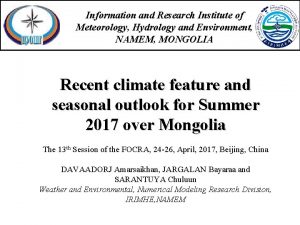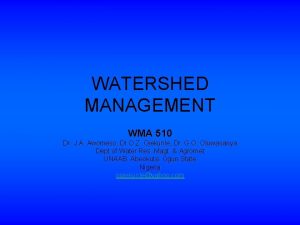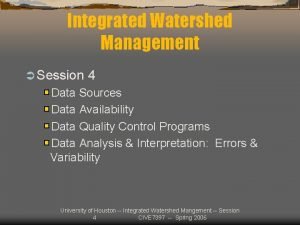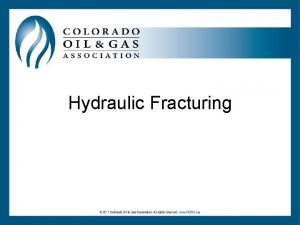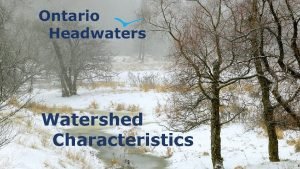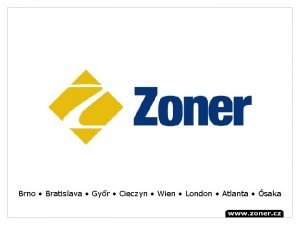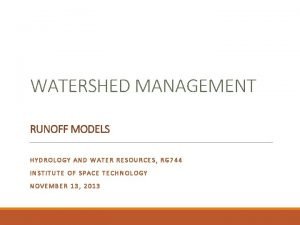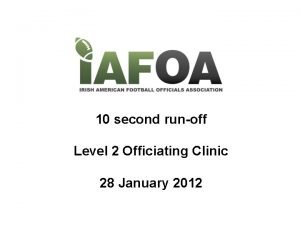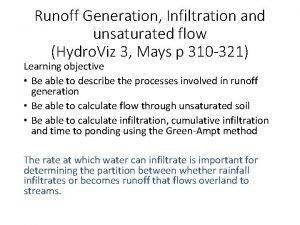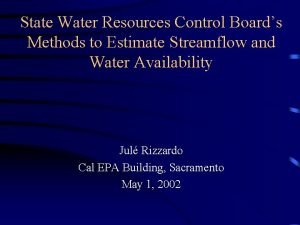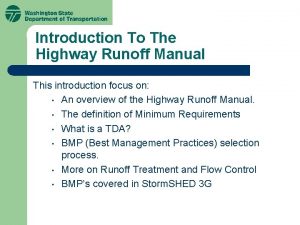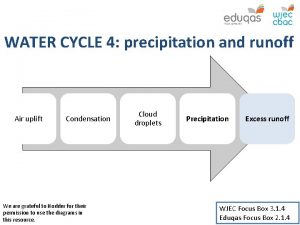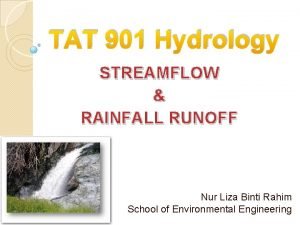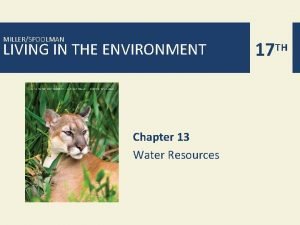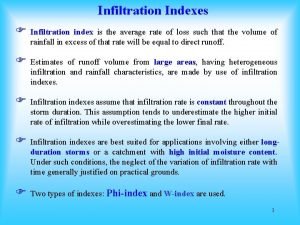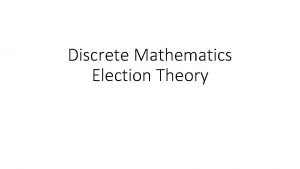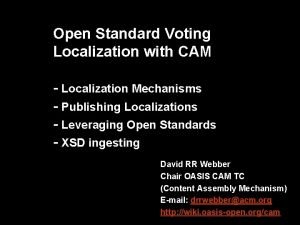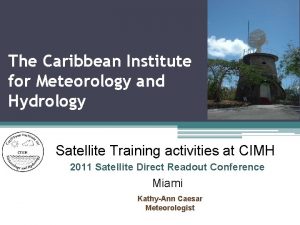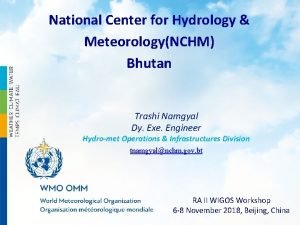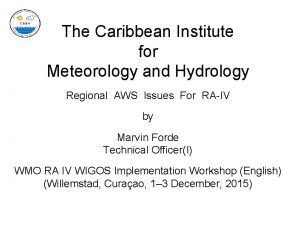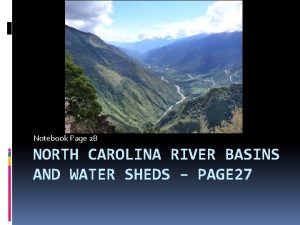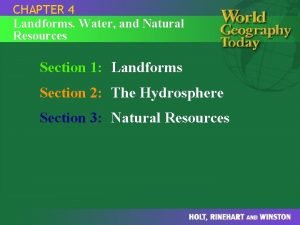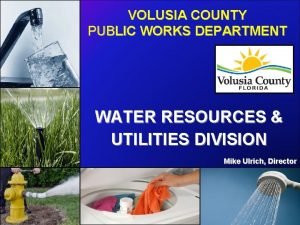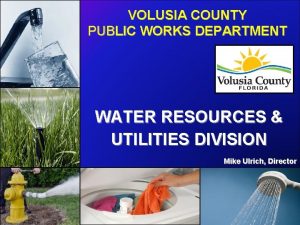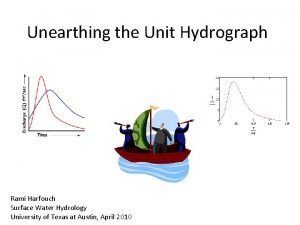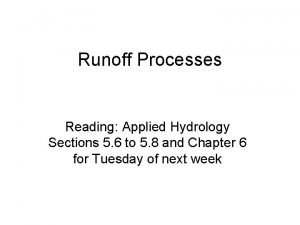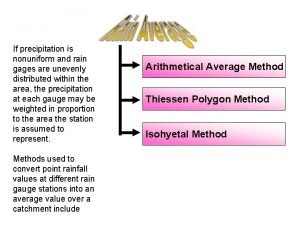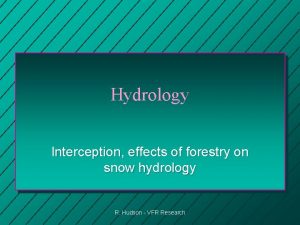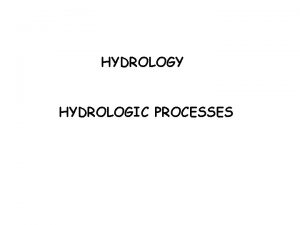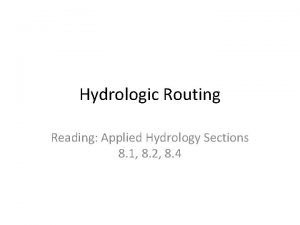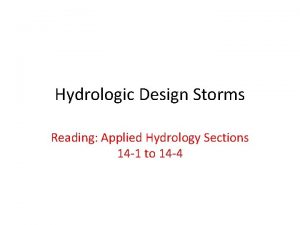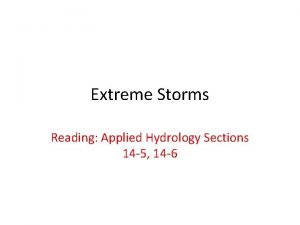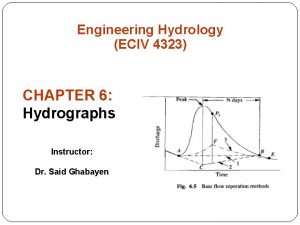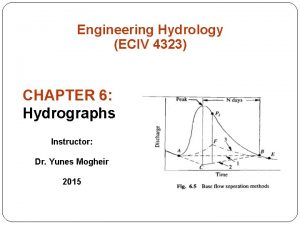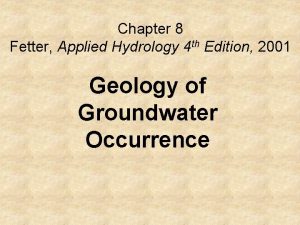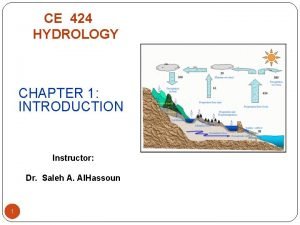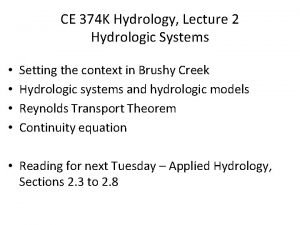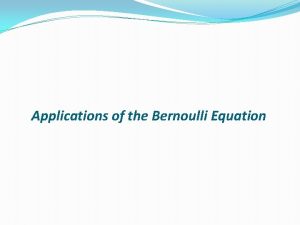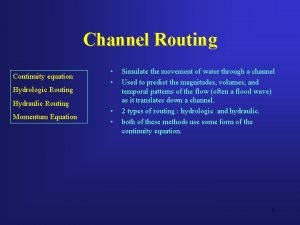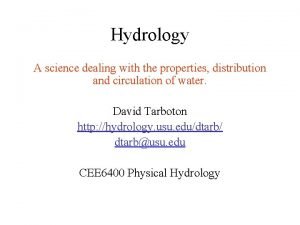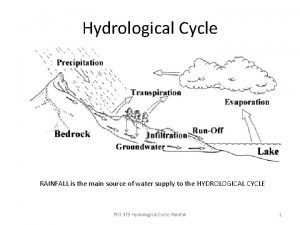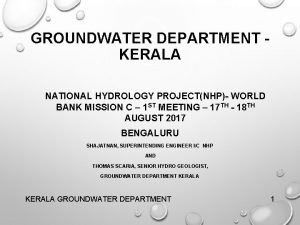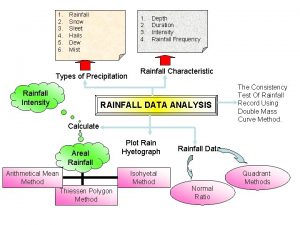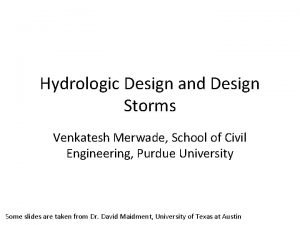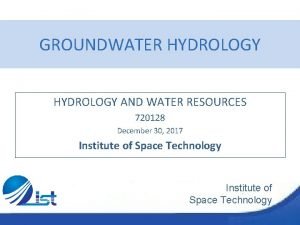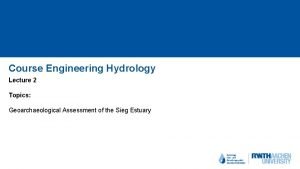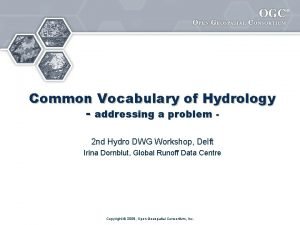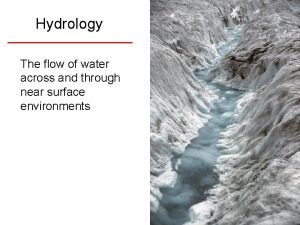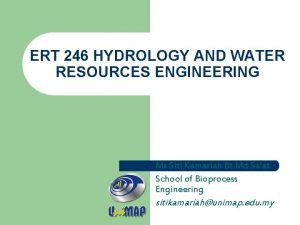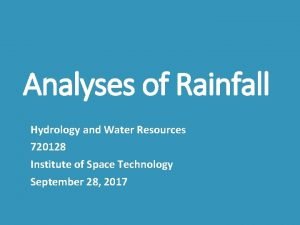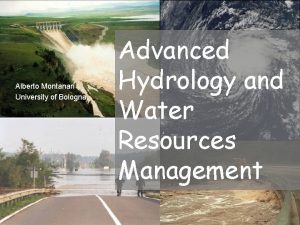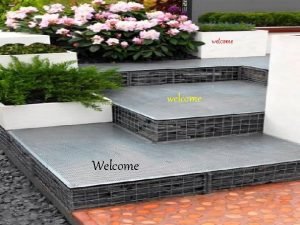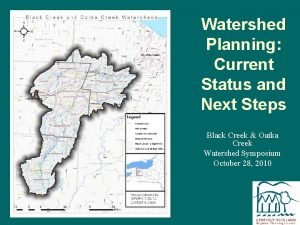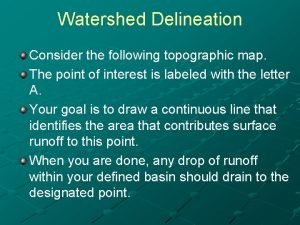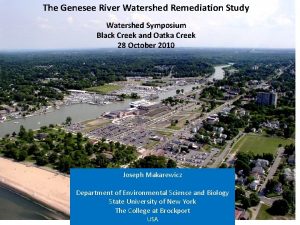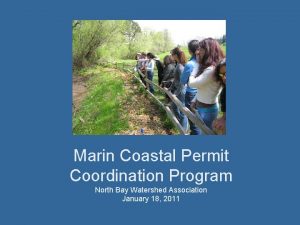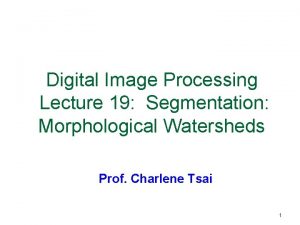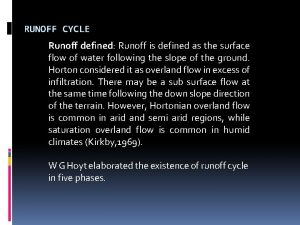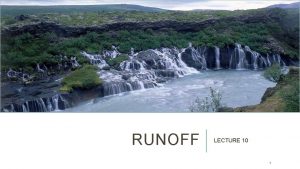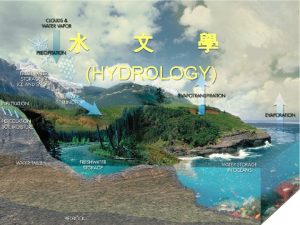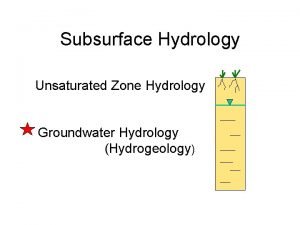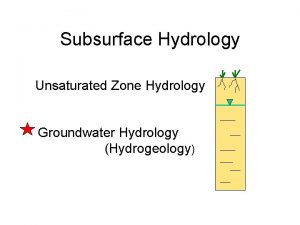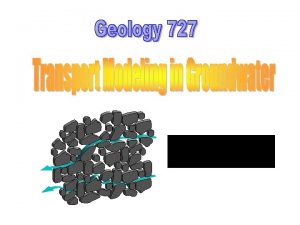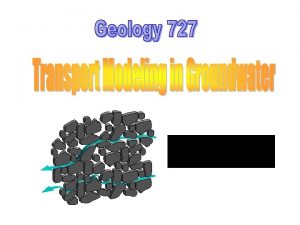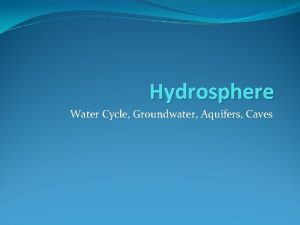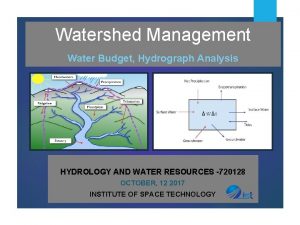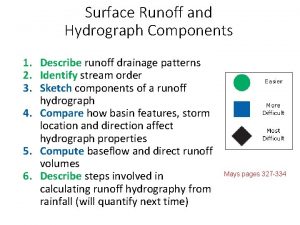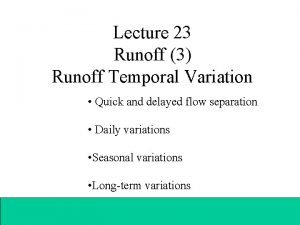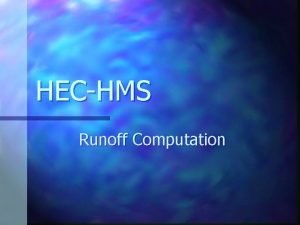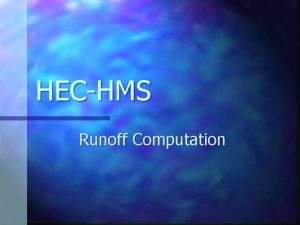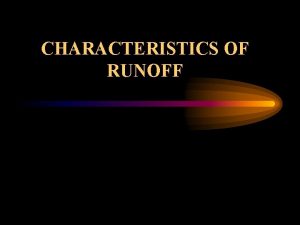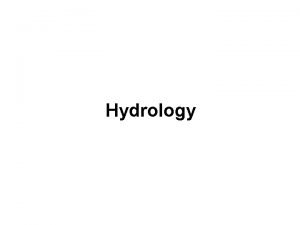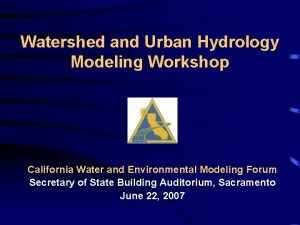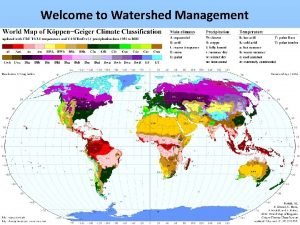WATERSHED MANAGEMENT RUNOFF MODELS HYDROLOGY AND WATER RESOURCES











































































- Slides: 75

WATERSHED MANAGEMENT RUNOFF MODELS HYDROLOGY AND WATER RESOURCES, RG 744 INSTITUTE OF SPACE TECHNOLOGY NOVEMBER 02 -06, 2015

RUNOFF MODELS Peak runoff models ◦ Provide only the estimates of peak discharge from the watershed Continuous runoff models ◦ This class of runoff models provides storm hydrographs for a given rainfall hyetograph ◦ Provide an estimate of runoff vs. time series 2

PEAK RUNOFF MODELS Rational Method NRCS Method 3

RATIONAL METHOD � To calculate peak runoff from small watersheds � Provides peak runoff rate from a catchment given: � � the runoff coefficient C, the time of concentration Tc, the area of the catchment, and the information to calculate the input or design storm or rainfall event 4

RATIONAL METHOD: ASSUMPTIONS Catchment is small (less than 200 acres) Catchment is concentrated Rainfall intensity is uniform over the area of study The runoff coefficient is catch-all coefficient that incorporates all losses of the catchment 5

RATIONAL METHOD: FORMULA Qp = CIi. A Qp = Peak discharge (cfs) C = runoff coefficient (function of soil type, landuse/cover and watershed slope) Ii = average rainfall intensity (in/hr) for a storm duration equal to the time of concentration, Tc A = area (acre) For runoff coefficient refer Bedient Table 6 -5 page 381 (more detailed table in Mc. Cuen book shared at course site) Obtain ‘I’ from IDF curve with tr (duration) and T defined (assume tr = Tc) 6

7

DETERMINING TC Take Tc = 5 min when A (acres) < 4. 6 S (slope %) Or use Kinematic Wave Theory (iterative process) L = length of overland flow plane (feet) S = slope (ft/ft) n = Manning roughness Ii= Rainfall intensity (in/hr) C = rational runoff coefficient 8

RATIONAL METHOD: EXAMPLE 6 -6 BEDIENT Drainage design to be accomplished for a 4 acre asphalt parking lot in Tallahassee for a 5 yr return period. The dimensions are such that the overland flow length is 1000 ft down a 1% slope. What will be the peak runoff rate? Refer Table 6 -5, 4 -2 & Figure 6 -5 Assume tr value, for that value read rainfall intensity from IDF curve. Calculate Tc using Kinematic wave theory. (iterate till tr = Tc) 9

RUNOFF COEFFICIENT FOR NONHOMOGENEOUS AREA Weighted runoff coefficient based on area of each land use Cw = ∑j=1 n Cj Aj/ ∑j=1 n Aj Example Mc. Cuen page 381 (378 in 2 nd Edition) 10

NRCS RUNOFF CURVE NUMBER METHODS By the USA Soil Conservation Service (now called the Natural Resources Conservation Service), division of the USDA (USA Department of Agriculture) To predict peak discharge due to a 24 -hr storm event Empirically derived relationships that use precipitation, land cover and physical characteristics of watershed to calculate runoff amount, peak discharges and hydrographs More sophisticated approach than Rational Method 11

NRCS CURVE NUMBER Curve number is a coefficient that reduces the total precipitation to runoff potential, after “losses” ◦ ◦ Evaporation Absorption Transpiration Surface Storage Higher the CN value - higher the runoff potential will be It is essential to use the CN value that best mimics the Ground Cover Type and Hydrologic Condition 12

NRCS RAINFALL-RUNOFF EQUATION Following equation presents relationship between accumulated rainfall and accumulated runoff Equation 1 Where: Q = accumulated direct runoff (in. or mm) P = accumulated rainfall (potential maximum runoff) (in. or mm) (24 -Hour Rainfall Depth versus Frequency Values) Ia = initial abstraction including surface storage, interception, evaporation and infiltration prior to any runoff occurring (in. or mm) S = potential maximum soil moisture retention after runoff begins (in. or mm) Note: for P ≤ Ia, Q = 0 13

POTENTIAL MAXIMUM RETENTION (S) potential maximum retention (S) can be calculated using Equation 2 Where: z=10 for English measurement units, or 254 for metric CN = Runoff Curve Number Generally, Ia may be estimated as Ia = 0. 2 S Substituting Ia value in Equation 1 Equation 3 Equation 4 14

NRCS RUNOFF EQUATIONS 15

Estimation of CN Previous equation (Fig. 2 -1)) can be rearranged so the CN can be estimated if rainfall and runoff volume are known (Pitt, 1994) The equation then becomes: 16

17

18

Curve Number CN The principal physical watershed characteristics affecting the relationship between rainfall and runoff are ◦ ◦ land use, land treatment, soil types, and land slope. NRCS method uses a combination of soil conditions and land uses (ground cover) to assign a runoff factor to an area (CN) CN indicates the runoff potential of an area ◦ Higher the CN, the higher the runoff potential Soil properties also influence the relationship between runoff and rainfall since soils have differing rates of infiltration Based on infiltration rates, the NRCS has divided soils into four hydrologic soil groups 19

COMPOSITE CURVE NUMBER When a drainage area has more than one land use When Composite CN is used ◦ Analysis does not take into account the location of the specific land uses ◦ drainage area is considered as a uniform land use represented by the composite curve number ◦ can be calculated by using the weighted method 20

HYDROLOGIC SOIL GROUPS Hydrologic Group is a grouping of soils that have similar runoff potential under similar storm and cover conditions Group A Soils: High infiltration (low runoff). Sand, loamy sand, or sandy loam. Infiltration rate > 0. 3 inch/hr when wet. Group B Soils: Moderate infiltration (moderate runoff). Silt loam or loam. Infiltration rate 0. 15 to 0. 3 inch/hr when wet. Group C Soils: Low infiltration (moderate to high runoff). Sandy clay loam. Infiltration rate 0. 05 to 0. 15 inch/hr when wet. Group D Soils: Very low infiltration (high runoff). Clay loam, silty clay loam, sandy clay, silty clay, or clay. Infiltration rate 0 to 0. 05 inch/hr when wet. Effects of Urbanization: Consider the effects of urbanization on the natural hydrologic soil group. If heavy equipment can be expected to compact the soil during construction or if grading will mix the surface and subsurface soils, you should make appropriate changes in the soil group selected. Antecedent soil moisture conditions: AMC I, II and III 21

ANTECEDENT SOIL MOISTURE CONDITIONS-AMC is the preceding relative moisture of the pervious surfaces prior to the rainfall event ◦ Low: when there has been little preceding rainfall ◦ High: when there has been considerable preceding rainfall prior to the modeled rainfall event ACM I (dry), ACM II (average) and ACM III (wet) For modeling purposes, we consider watersheds to be AMC II, which is essentially an average moisture condition Areas with high water table conditions may want to consider using AMC III antecedent soil moisture conditions. 22

CNs A CN of 100 is to be used for permanent water surfaces such as lakes and ponds 23




EXAMPLE 27

28

CONTINUOUS RUNOFF MODELS Time area method Unit Hydrograph Techniques 29

TIME AREA METHOD Develop to address non-uniform rainfall in large areas Convert rainfall excess into hydrograph Concept of time-area histogram is used This method assumes that outflow hydrograph results from pure translation of direct runoff to the outlet at uniform velocity, ignoring any storage effects in the watershed Watershed divided into subareas with distinct runoff translation times to the outlet Subareas are delineated with isochrones of equal translation time (numbered upstream from the outlet) 30

TIME AREA METHOD If a rainfall of uniform intensity is distributed over the watershed area, water first flows from areas as immediately adjacent to the outlet Percentage of the total area contributing increases progressively in time Example : Surface runoff from area A 1 will reach the outlet first, followed by contributions from A 2, A 3, …. . and so on Qn = Ri. A 1+Ri-1 A 2+……. R 1 Aj Qn = Hydraulic ordinate at time n (cfs) Ri= excess rainfall ordinate at time i (ft/s) Aj= time-area histogram ordinate at time j (ft 2) 31

32

EXAMPLE 2 -2 FROM BEDIENT PAGE 112 Time area histogram method. The following is an example of the inflow for hour 5 using the 5 hour rainfall and 4 sub-basins. Assume constant rainfall intensity of 0. 5 in/hr 33

UNIT HYDROGRAPH (UHG) THEORY Unit Hydrograph of a watershed is defined as the direct runoff hydrograph resulting from a unit depth of rainfall excess (1 in or 1 cm) distributed uniformly over a drainage area at a constant rate for an effective duration The effective rainfall is considered uniformly distributed within its duration and throughout the whole area of the basin Uniquely represents storm-flow response (hydrograph shape) for a given watershed 34

UNIT HYDROGRAPH THEORY: ASSUMPTIONS 1. The effective rainfall is uniformly distributed within its duration 2. The effective rainfall is uniformly distributed throughout the whole area of the basin 3. The base period of the direct runoff hydrograph produced by effective rainfall of same duration (intensities may be different) are also same 4. The ordinates of the direct runoff hydrographs of a common base period are directly proportional to the total volume of direct runoff represented by the respective hydrographs 5. For a given drainage basin the hydrograph of runoff due to a given period of rainfall reflects the unchanging characteristics of the basin 35

UNIT HYDROGRAPH THEORY: ASSUMPTIONS 2 Basic Assumptions: Time Invariance ◦ Direct runoff response to a given effective rainfall in a catchment is time invariant, i. e. direct-runoff hydrograph (DRH) for a given excess rainfall in a catchment is always the same irrespective of when it occurs Linear Response ◦ Direct runoff response to the rainfall excess is assumed to be linear. Means if inputs x 1(t), x 2(t) cause outputs y 1(t) and y 2(t) respectively then an input x 1(t) + x 2(t) will cause an output y 1(t) + y 2(t). Also if x 1(t) = r x 2(t) then y 1(t) = r y 2(t). 36

LINEAR RESPONSE UH is 1/2 the size but TB (time base) and TP (time to peak) are the same 37

TYPICAL UNIT HYDROGRAPH 38

PROPERTIES OF UNIT HYDROGRAPH Volume under unit hydrograph is equal to 1 unit rainfall excess (1 in or cm) If duration of 2 rainfall excess events is equal without regard to their respective rainfall intensities, they must result in the same hydrograph time base Results in a linear system whereby the direct runoff for storm of specified duration is directly proportional to the rainfall excess amount or volume Rainfall distribution for all equal duration storms is identical in time and space 39

DEVELOPMENT OF UHG Examine records of watershed for single peaked, isolated stream flow hydrographs resulting from short duration rainfall hyetograph of relatively uniform intensity Determine depth of storm precipitation spread over the watershed equivalent to the volume of water divided by area ◦ Volume is equal to area under hydrograph Ordinates of UHG can be calculated by dividing the ordinates of the DRH by the storm depth Check: recalculate area under UHG and divide it by watershed area. That should give unit storm depth. 40

EXAMPLE: Determine the UHG ordinates for the hydrograph shown in figure. The area of watershed is 16. 2 square km 41

42

43

EXAMPLE 44

TABLE: 45

3. 5 CM DIRECT RUNOFF HYDROGRAPH 46

DRH ORDINATES FROM UHG WITH VARIABLE RAINFALL EXCESS VALUES (M PULSES OF EXCESS RAINFALL Discrete Convolution Equation is used to compute direct runoff hydrograph ordinates Qn = direct runoff hydrograph ordinates, Pm= Rainfall excess, Un-m+1 = unit hydrograph ordinates, n= direct runoff hydrograph time interval (1, 2, …N), m= precipitation time interval M = pulses of excess of rainfall N = pulses of direct runoff N-M+1 = L, Number of UH ordinates Reverse process is called ‘deconvolution’ to derive unit hydrograph given Pm and Qn 47

DISCRETE TIME CONVOLUTION EQUATIONS 48

APPLICATION OF UHG TO RAINFALL INPUT 49

DECONVOLUTION PROCESS Q n and Pm are known Q 1 = P 1 * U 1 (Q 1 and P 1 known, calculate U 1) Q 2= P 2*U 1 + P 1 *U 2 (all known except U 2) And so on 50

Example: 51

EXAMPLE Hard copies provided in class Reading material on Hydrograph Analysis: http: //www. civil. pdn. ac. lk/acstaff/urrathnayake/CE_205 -UR-Note 1. pdf 52

INSTANTANEOUS UNIT HYDROGRAPH Limiting the duration of UHG to zero an Instantaneous Unit Hydrograph is obtained Instantaneous Unit Hydrograph is the hydrograph resulting from an instantaneous rainfall of one unit uniformly over the basin IUH was first proposed by Clark in 1945 DIMENSIONLESS UNIT HYDROGRAPH DRH whose ◦ ordinates are given as ratios of the peak discharge and ◦ time axis is defined as the ratio of the time to peak Dimensionless UH has an axis system of qlqp versus tltp (qp is the discharge rate at the time to peak tp) 53

SYNTHETIC UHG When observed rainfall/runoff data for a catchment is not available to derive UHG Construct synthetic UHG based on empirical functions (basin’s physical characteristics) ◦ Developing UHG for other locations on the stream in the same watershed or other watersheds that are of similar character with known data 1. Snyder’s Unit Hydrograph 2. SCS Dimensionless Unit Hydrograph 3. Clark (time area method) 54

SNYDER UHG Relates the time from the centroid of the rainfall to the peak of the UHG to geometrical characteristics of the watershed Important factors to be considered for a UGH are; ◦ peak flow and time of peak flow ◦ Coefficient derived from gaged watershed in the area Cp and Ct ◦ Cp = peak flow factor, and Ct = lag factor. Basic Assumption of Synder’s Method: ◦ that basins which have similar physiographic characteristics are located in the same area will have similar values of Cp and Ct Therefore, for ungagged basins, it is preferred that the basin be near or similar to gaged basins for which these coefficients can be determined 55

Snyder’s UHG: Computing Ct 56

Snyder’s UHG: Computing Cp 57

Characteristics of a Standard UHG 58

59

Snyder: Development of a Required UHG assuming that Ct, Cp, L, and Lc are known Required: a unit hydrograph whose associated effective rainfall pulse duration is t. R for an ungagged watershed 1. Use equation 2 to determine the lag-time, tp 2. If t. R meets the criterion for a standard UHG (tp = 5. 5 t. R) then the required unit hydrograph is a standard UHG ◦ equations 2 and 3 can be used directly to estimate the peak discharge and the time to peak of the required unit hydrograph 3. If t. R does not meet the criterion for a standard UHG ◦ In this case, the lag-time of the required unit hydrograph, tp. R, is tp. R = tp – (tr – t. R)/4 ------ 4 ◦ where tp is obtained from equation 2, tr is obtained from equation 1 and t. R is given. 60

Conti… 4. The peak discharge of the required UHG, Qp. R, is, Qp. R = Qp tp/tp. R ---- 5 where Qp is obtained from equation 3 5. Assuming a triangular shape for the UHG, and given that the UHG represents a direct runoff volume of 1 cm (1 in), the base time of the required UHG may be estimated by tb = C 3 A/Qp. R ------- 6 where C 3 is 5. 56 (1290 for the English system) 61

Drawing Snyder’s UHG Relationships for the widths of the UHG at values of 50% (W 50) and 75% (W 75) of Qp. R developed by U. S. Army Corps of Engineers; W% = Cw(Qp. R/A)-1. 08 where the constant Cw is 1. 22 (440 for English units) for the 75% width and equals to 2. 14 (770 for English units) for the 50% width 62

Snyder’s Synthetic UHG 63

Example: Snyder’s Method 64

Homework Solve Example 5. 8 of Hydrology Principles. Due date: Next class. (No homework will be accepted after that) 65

SCS UNIT HYDROGRAPH

CLARK’S IUH Time-Area Method (concept of isochrones)



Calculate lag time

HYDROGRAPHS Floods 2013 in Sindh 71

72

73

74

75
 Meteorology hydrology and water management
Meteorology hydrology and water management Water and water and water water
Water and water and water water Water cycle infiltration
Water cycle infiltration Watershed management meaning
Watershed management meaning Integrated watershed management
Integrated watershed management Watershed management
Watershed management The importance of water resources
The importance of water resources Characteristics of a watershed
Characteristics of a watershed Atlanta watershed management
Atlanta watershed management Qp formula
Qp formula 10 second run off
10 second run off Runoff generation
Runoff generation Runoff coefficient
Runoff coefficient Highway runoff manual
Highway runoff manual Khosla formula for runoff
Khosla formula for runoff Air uplift
Air uplift What is a runoff sentence
What is a runoff sentence Factors affecting runoff
Factors affecting runoff How to prevent soil runoff on a slope
How to prevent soil runoff on a slope Scs curve number
Scs curve number Who is the
Who is the Instant runoff voting excel template
Instant runoff voting excel template Modal and semi modal verbs
Modal and semi modal verbs Transformed resources and transforming resources
Transformed resources and transforming resources Fixed resources definition
Fixed resources definition Caribbean institute for meteorology and hydrology
Caribbean institute for meteorology and hydrology Nchm bhutan
Nchm bhutan Caribbean institute for meteorology and hydrology
Caribbean institute for meteorology and hydrology Renewable resources vs nonrenewable resources
Renewable resources vs nonrenewable resources Discover north carolina's river basins
Discover north carolina's river basins Natural resources from landforms
Natural resources from landforms Air and water resources lesson 4
Air and water resources lesson 4 Volusia county water
Volusia county water Volusia county water
Volusia county water Applied hydrology
Applied hydrology Scs method
Scs method Arithmetic mean rainfall
Arithmetic mean rainfall Hydrology study guide
Hydrology study guide Drh meaning in hydrology
Drh meaning in hydrology Interception hydrology
Interception hydrology Applied hydrology
Applied hydrology Applied hydrology
Applied hydrology Applied hydrology
Applied hydrology Applied hydrology
Applied hydrology The basic assumptions of unit hydrograph theory are
The basic assumptions of unit hydrograph theory are Drh in hydrology
Drh in hydrology Applied hydrology
Applied hydrology Continuity equation
Continuity equation Qg 424
Qg 424 Reynolds transport theorem
Reynolds transport theorem Bernoulli's equation application
Bernoulli's equation application Branches of hydrology
Branches of hydrology Hydrologic continuity equation
Hydrologic continuity equation Continuity equation hydrology
Continuity equation hydrology Hydrology lecture
Hydrology lecture Brutsaert
Brutsaert Quadrant method hydrology
Quadrant method hydrology Hydrology department kerala
Hydrology department kerala Water drops
Water drops Design storm in hydrology
Design storm in hydrology بئر ارتوازي
بئر ارتوازي Hydrology
Hydrology International glossary of hydrology
International glossary of hydrology Return flow in hydrology
Return flow in hydrology What is hydrology
What is hydrology In greek language hudor means *
In greek language hudor means * Dad curve hydrology
Dad curve hydrology Advanced hydrology
Advanced hydrology Wawa atlanta
Wawa atlanta Gabion structure watershed
Gabion structure watershed Components of a watershed
Components of a watershed Watershed delineation
Watershed delineation Genesee river watershed
Genesee river watershed North bay watershed association
North bay watershed association Morphological watershed
Morphological watershed 9 gough square
9 gough square
